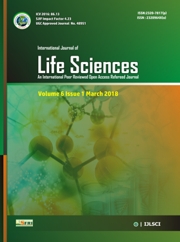Research Article
Volume 8 |Issue 6| November-December 2020 First published: 31 December 2020
Study on Physico-Chemical parameters of Yaldali Dam, Parbhani (M.S.), India.
Walale MP and SD Rathod
P. G. and Research Department of Zoology, R. A. Arts, Shri M. K. Commerce and Shri S. R. Rathi Science College, Washim-444505
Email: mangeshwalale93@gmail.com
Abstract
Keywords:Physicochemical Parametrs, Yeldari Dam, Parbhani.
Cite this article as:
Walale MP and SD Rathod. Study on Physico-Chemical parameters of Yaldali Dam, Parbhani (M.S.), India., Int. Res. Journal of Science & Engineering, 2020, Volume 8(6): 255-262.
Copyright:
Open Access This article is licensed under a Creative Commons Attribution 4.0 International License, which permits use, sharing, adaptation, distribution and reproduction in any medium or format, as long as you give appropriate credit to the original author() and the source, provide a link to the Creative Commons license, and indicate if changes were made. The images or other third party material in this article are included in the article’s Creative Commons license, unless indicated otherwise in a credit line to the material. If material is not included in the article’s Creative Commons license and your intended use is not permitted by statutory regulation or exceeds the permitted use, you will need to obtain permission directly from the copyright holder. To view a copy of this license, visit http://creativecommons.org/ licenses/by/4.0/
References
1. Agarwal, A.K. and G.S. Rajwar (2010): Physico-chemical and Microbial Study of Tehri Dam Reservoir Garhwal, Himalaya, India. Journal of America Science 2010; 6 (6).
2. APHA (1998) : Standard Method for the examination of water and wastewater, 20th edition. American Public Health Association New York, ISBN-O-87553-235-7.
3. Arvindkumar,(1995) : Some Immunological Aspects of Fresh water Tropical wetland of Santhal. Pargana (Bihar) India, J. Envi. Poll. 2 (3): 137-141.
4. Borul S. B. (2012): Study of water quality of Lonar lake. J. Journal of Chemical and Pharmaceutical Research. Vol. 4(3). PP: 1716-1718.
5. Dabhade, D. S., (2013): Eutrophication, A Threat To Saline Lake In A Crater At Lonar, Maharashtra. Asian Journal of Contemporary Sciences Vol. 2(1) 1-6.
6. Dabhade, D.S. and R.A. Malu (2006) : Rotifers in Crater Lake of Lonar, Dist. Buldhana (MS). Aquatic Biodiversity Management And Conservation, Nature Conservator, Publication – 9, 31-34, ISBN: 81 – 900467 -6-5.
7. Harney N.V., A.A. Dhamani and R.J. Andrew(2013) : Seasonal Variation in The Physico-chemical Parameters of Pindavani pond of Central India. J. DOI: 10.9780/2321-7871/162013/18, vol.I Issue_6 ISSN:2321-7871.
8. Hujare, M.S. (2008): Seasonal variation of physico-chemical parameters in the perennial tank of Talsande, Maharashtra. Ecotoxicol, Environ. Biol. 11(3), 335-343.
9. Hutchinson, G.E., (1957): A treatise on limnology vol. I. and II Geography, physics and chemistry,John Wiley and Sons, New York, pp:1015.
10. Karadkhede, S.V., M.V.Lokhande,D S. Rathod, V. S. Shembekar and S. M. Patil (2008): Studies on physic-chemical characterstics of recreational water body in Nana-Nani Park,Latur, Maharashtra.J.Aqua.Biol.,23(1): 55-58.
11. Khan, R.M., M.J. Jadhav and I.R. Ustad (2012): Physicochemical analysis of Triveni Lake water of Amravati district in (MS) India., Bioscience discovery, 3(1): 64-66.
12. Koshy and Nayar (2000): Water quality of river Pamba at Kozhencherry. Poll.Res., 19(4):665-668.
13. Makode P.M. (2012): Physico-Chemical parameters Charghad Dam district Amravati, Maharashtra.
14. Manjare, S. A., S. A. Vhanalakar and D.V. Muley (2010): Analysis of water quality using physico-chemical parameters tamdalge tank in Kolhapur district, Maharashtra. International Journal of advanced biotechnology and research. ISSN 0976 – 2612, Vol. 1, Issue 2; Dec – 2010 PP. 115-119.
15. Medudhula. T. Ch. Samatha, Ch. Sammaiah (2012): Analysis of water quality using physic-chemical parameters in lower manair reservoir of Karimnagar district, Andra Pradesh.
16. Pailwan, I. F., D.V. Muley and S. Maske (2008): Limnological features, Plankton Diversity and Fishery Status of three fresh water perennial Tank of Kolhapur District (MS) India.
17. Parida,R.N., S.Nanda and R.K.Rath (1999): Physico-chemical features of water and soil in rural fish ponds and its relationship with pond productivity. J. of Aquaculture. 7: 17-23.
18. Patil, A.A.(2014): Limnological and Correlation studies of Birnal water body of Sangali, Maharashtra. International Research Journal of Environment Sciences, vol3(9),43-49.
19. Pulugandi C.(2014): Analysis of water quality parameters in Vembakotti water reservoir, Virudhunagar district, Tamil Nadu – A report. Res.J. Recent Sci. ISSN 2277-2502.
20. Rani,R., Gupta, B.K. and Srivastav, K.B.L., (2004): Studies on water quality assessment in Satna city (M.P.): Seasonal parametric variation, Nature environment and pollution technology, 3(4). pp 563-565.
21. Ravikumar ,M.,S. Manijappa, B.R. kiran and E.T.(2005): Hydtochemistry of Ayyanakere Tank in Harpanhalli Town, Davanagere, Karnataka. J. Aqua. Biol.20(2) : 117-120.
22. Satyanarayan, S., P.R. Chaudhari and S. Dhadse (2008): Limnological Study on Lonar Lake: A Unique Brackish Crater Lake in India Sengupta, M. and Dalwani, R. (Editors). Proceedings of Taal 2007: The 12th World Lake Conference: 2061-2066.
23. Sharma, K.P., Goel,P.K. and B,Gopal(1978): Limnological studies of Polluted fresh water I “physic-chemical characterstics” Ind J. Ecil. Environ Sci 4 pp-88-105.
24. Shinde V. A. and S.M. More (2013): Study of physicochemical characterization of lonar lake effecting biodiversity lonar lake, maharashtra, india. J. International Research Journal of Environment Sciences. Vol. 2(12), 25-28.
25. Shinde, S.E.,T.S. Pathan,K.S. Raut and D.L.Sonawane (2011): Studies on the physic-chemical parameters and correlation coefficient of Harsool-savangi dam, district Aurangabad, India. Middle-East Journal of Scientific Research 8(3): 544-554.
26. Siddiqi, S.Z. (2008): Limnological profile of high-impact meteor crater Lake Lonar, Buldana, Maharashtra, India, an extreme hyperalkaline, saline habitat. Proceedings of Taal2007: The 12th World Lake Conference: 1597-1613.
27. Siddique, K. F., and M. K. Kale (2018): Species Diversity of Zooplankton and Physico-chemical Parameters of Wanjarwadi and Ukhanda Dam of Beed District (M.S.), India International Journal of Universal Print Vol 4(8) 450-463.
28. Singh S.M. , S.C. Panday., S.Pani and A. Malhosia (2012 ): Limnology : A case study of highly polluted Laharpur reservoir, Bhopal, (M.P.) India. J. of Chemical, Biological and Physical Sciences. Vol.2(3),1560-1566, e-ISSN: 2249-1929.
29. Sivakumar, K. and R. Karuppasamy (2008): Factors affecting productivity of phytoplankton in a Reservoir of Tamilnadu, India. American – Eurosian Journal of Botany 1(3): 99 – 103, 200.
30. Solanki,H.A. and B.R. Pandit (2006): Trophic status of lentic waters of ponds water of Vadodara, Gujrat state, India. Int.J. of “Bioscience Reporter” 4(1): 191 -198.
31. Verma P.U. , D.K. Chandawat and H.A. Solanki (2011): Seasonal variation in physic-chemical and Phytoplankton analysis of Kankaria Lake,Gujrat University, Ahmedabad _Gujrat, Life science Leaflets 19:842, ISSN 0976-1098.
32. Verma P.U. , D.K. Chandawat and H.A. Solanki (2011): Seasonal variation in physic-chemical and Phytoplankton analysis of Kankaria Lake,Gujrat University, Ahmedabad _Gujrat, Life science Leaflets 19:842, ISSN 0976-1098.
33. W.H.O.(1993) : Guidelines for driking water quality (vol.2.): Recommendations, World Health Organization, Geneva.

